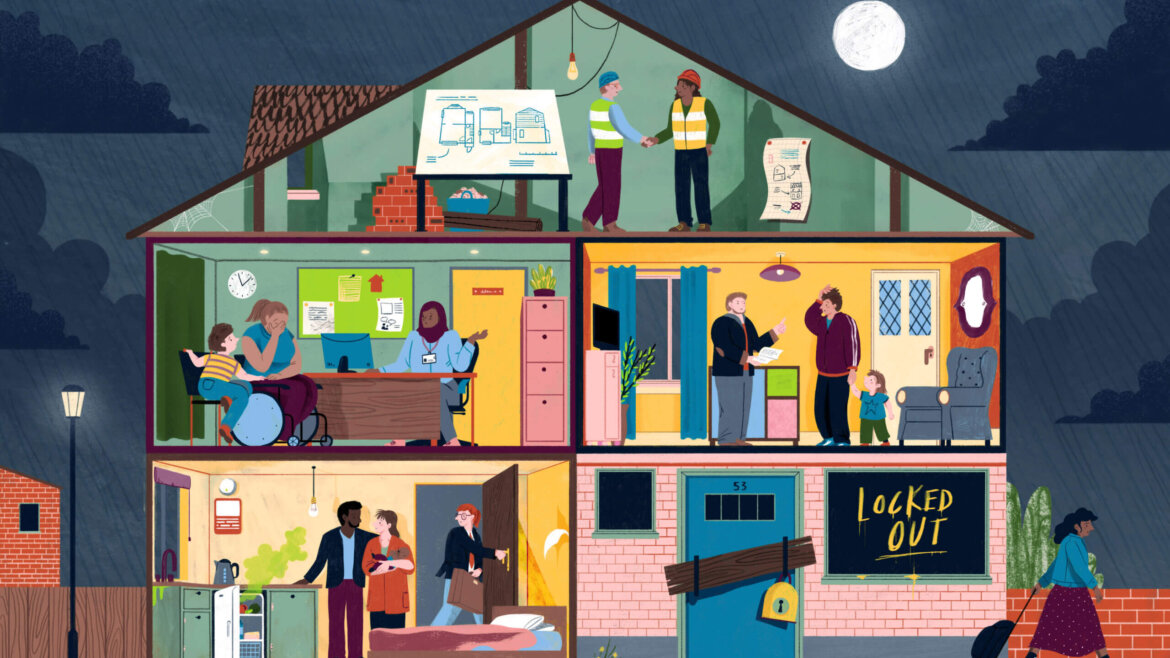In 2010, the U.S. Department of Housing and Urban Development (HUD), began working with other federal partners to set concrete goals for ending and preventing homelessness (Housing Crisis Triage Policies and Procedures). As part of the plan, HUD requires that each Continuum of Care (CoC) establish a comprehensive crisis response system to prioritize people most in need of assistance, such as those experiencing homelessness. In Fayette County, this means that all of our 70+ Lex End Homelessness partners are working together to ensure that everyone has access to safe, stable, and affordable housing.
An important part of our crisis response system is Coordinated Entry. This process has seven steps and is designed to help CoC partners understand people’s needs and connect them to the appropriate resources.

- The first step is access. Anyone experiencing housing insecurity can reach out to any participating community partner. With our “no wrong door” policy, people in need of assistance are easily able to get help.
- The next step is crisis needs screening. During this step, the organization assesses a person’s most critical needs. Based on this information, the organization will also be able to refer someone seeking assistance to the appropriate community resources with the hopes of avoiding the cycle of homelessness.
- The third step is housing needs screening. After assessing someone’s crisis needs, the organization will screen for housing and service needs for those already experiencing homelessness. This screening process is standardized to ensure everyone receives the best care possible.
- The fourth step is creating a by-name-list. At this point, information from the screening is placed into the Lexington-Fayette County Coordinated Entry Prioritization List. This step makes sure that those experiencing homelessness receive support in a timely manner.
- Next, the fifth step is determining prioritization. The partner will work with those seeking assistance and local partner agencies to house the most critical cases. By keeping an organized list, the Continuum of Care makes sure that nobody is left behind or forgotten.
- The sixth step is referral. At this stage, the individual or family experiencing homelessness is referred directly to a housing program. This means that there is no lapse in care for those in need of assistance.
- Finally, the last step is placement. At this stage, people experiencing homelessness are provided with safe, stable, and affordable housing (Housing Crisis Triage Policies and Procedures).
This system benefits both individuals or families experiencing homelessness and the CoC partners. People in need of assistance do not have to navigate complex systems or guess which resource is available to them. Since Coordinated Entry prioritizes understanding how other factors, such as medical needs, affect housing, this system ensures that people are given comprehensive care that is appropriate for their unique situation. Recent data on homelessness shows that the number of people experiencing homelessness in Fayette County decreased from 1,544 in 2014, to 689 in 2020 (Lexington Office of Homelessness Prevention and Intervention), which is evidence that our housing crisis response system helps our partners to get people housed in our community.
Furthermore, because this system means that all partners are tied together, case managers are able to focus on intake and screening while still having access to the resources of other organizations. This process helps case managers know which services are necessary and also helps partners identify gaps in services that need to be resolved in order to provide the best assistance. Because we prioritize communicating between partners, the data shows that Coordinated Entry also helps us to get people housed more quickly and cost effectively.
By offering a menu of services to best fit an individual’s or family’s needs, this system helps house those in critical need and breaks down the structural barriers to ending homelessness. By using data-driven programs and processes, the Continuum of Care provides partners with the training and support necessary to end and prevent homelessness in Lexington-Fayette County.
To read and access data that shows the positive impacts of Coordinated Entry, visit our data dashboard with up to date information about homelessness in the Lexington community.
To continue to learn more about Lex End Homelessness and the Continuum of Care bookmark the LEH website at: lexendhomelessness.com. You can also follow LEH on Facebook, Twitter, Instagram, and LinkedIn.
Facebook - @LexEndHomelessness
Twitter - @lexendhomeless
Instagram - @LexEndHomelessness
LinkedIn - @Lex End Homelessness



